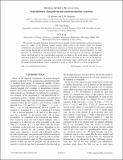| dc.contributor.author | Van Orden, J. W. | |
| dc.contributor.author | Ford, W. P. | |
| dc.contributor.author | Moreno Diaz, Oscar | |
| dc.contributor.author | Donnelly, T William | |
| dc.date.accessioned | 2014-08-08T14:25:51Z | |
| dc.date.available | 2014-08-08T14:25:51Z | |
| dc.date.issued | 2014-07 | |
| dc.date.submitted | 2014-06 | |
| dc.identifier.issn | 1550-7998 | |
| dc.identifier.issn | 1550-2368 | |
| dc.identifier.uri | http://hdl.handle.net/1721.1/88609 | |
| dc.description.abstract | The general, universal formalism for semi-inclusive charged-current (anti)neutrino-nucleus reactions is given for studies of any hadronic system, namely, either nuclei or the nucleon itself. The detailed developments are presented with the former in mind and are further specialized to cases where the final-state charged lepton and an ejected nucleon are presumed to be detected. General kinematics for such processes are summarized, and then explicit expressions are developed for the leptonic and hadronic tensors involved and for the corresponding responses according to the usual charge, longitudinal and transverse projections, keeping finite the masses of all particles involved. In the case of the hadronic responses, general symmetry principles are invoked to determine which contributions can occur. Finally, the general leptonic-hadronic tensor contraction is given as well as the cross section for the process. | en_US |
| dc.description.sponsorship | United States. Dept. of Energy (Cooperative Research Agreement DE-FC02-94ER40818) | en_US |
| dc.publisher | American Physical Society | en_US |
| dc.relation.isversionof | http://dx.doi.org/10.1103/PhysRevD.90.013014 | en_US |
| dc.rights | Article is made available in accordance with the publisher's policy and may be subject to US copyright law. Please refer to the publisher's site for terms of use. | en_US |
| dc.source | American Physical Society | en_US |
| dc.title | Semi-inclusive charged-current neutrino-nucleus reactions | en_US |
| dc.type | Article | en_US |
| dc.identifier.citation | Moreno, O., T. W. Donnelly, J. W. Van Orden, and W. P. Ford. "Semi-inclusive charged-current neutrino-nucleus reactions." Physical Review D (2014), 90(1): 013014-1-013014-14. © 2014 American Physical Society | en_US |
| dc.contributor.department | Massachusetts Institute of Technology. Center for Theoretical Physics | en_US |
| dc.contributor.department | Massachusetts Institute of Technology. Department of Physics | en_US |
| dc.contributor.department | Massachusetts Institute of Technology. Laboratory for Nuclear Science | en_US |
| dc.contributor.mitauthor | Moreno Diaz, Oscar | en_US |
| dc.contributor.mitauthor | Donnelly, T. William | en_US |
| dc.relation.journal | Physical Review D | en_US |
| dc.eprint.version | Final published version | en_US |
| dc.type.uri | http://purl.org/eprint/type/JournalArticle | en_US |
| eprint.status | http://purl.org/eprint/status/PeerReviewed | en_US |
| dc.date.updated | 2014-07-23T20:46:54Z | |
| dc.language.rfc3066 | en | |
| dc.rights.holder | American Physical Society | |
| dspace.orderedauthors | Moreno, O.; Donnelly, T. W.; Van Orden, J. W.; Ford, W. P. | en_US |
| dc.identifier.orcid | https://orcid.org/0000-0002-3524-1432 | |
| mit.license | PUBLISHER_POLICY | en_US |
| mit.metadata.status | Complete | |
